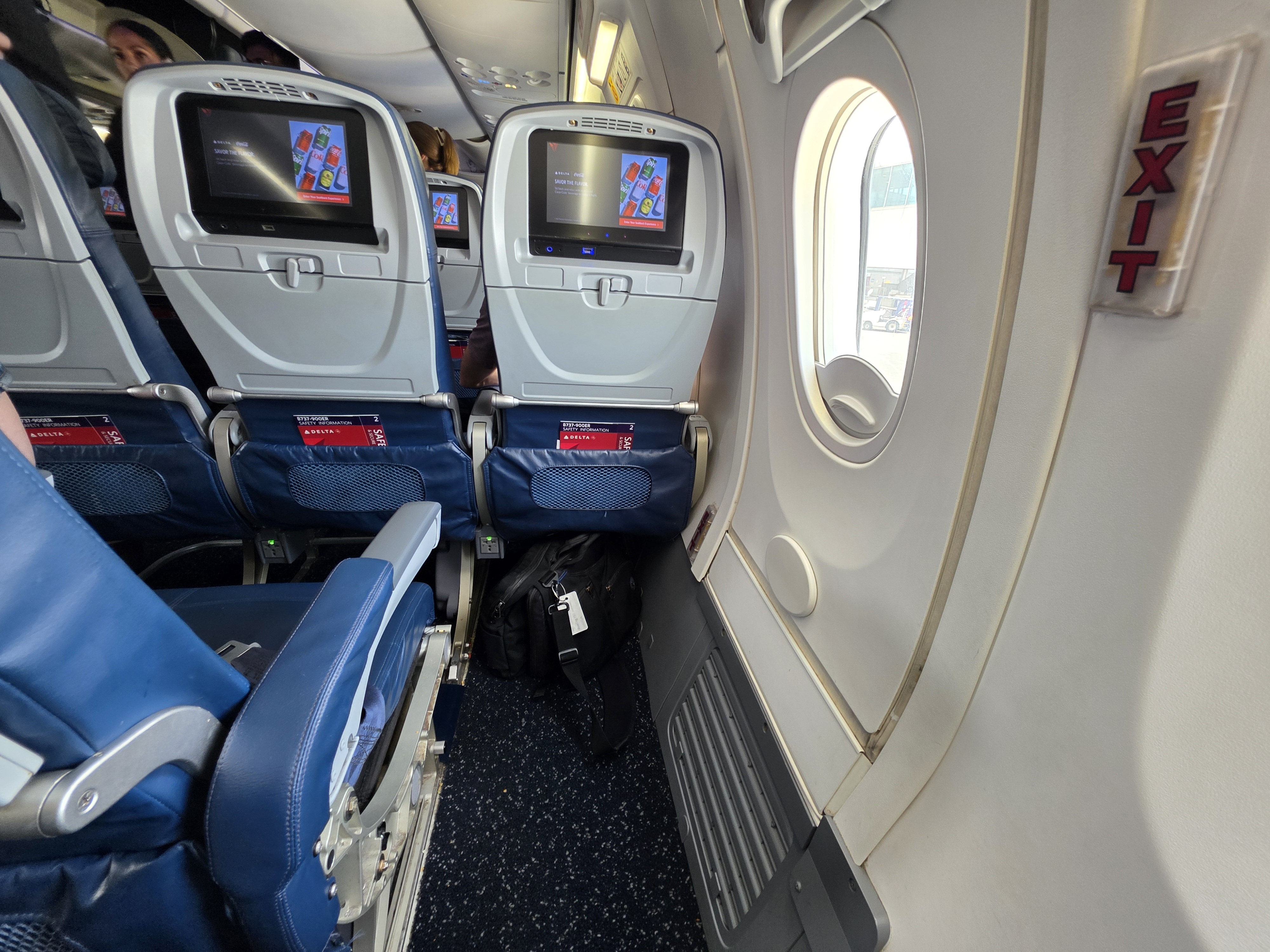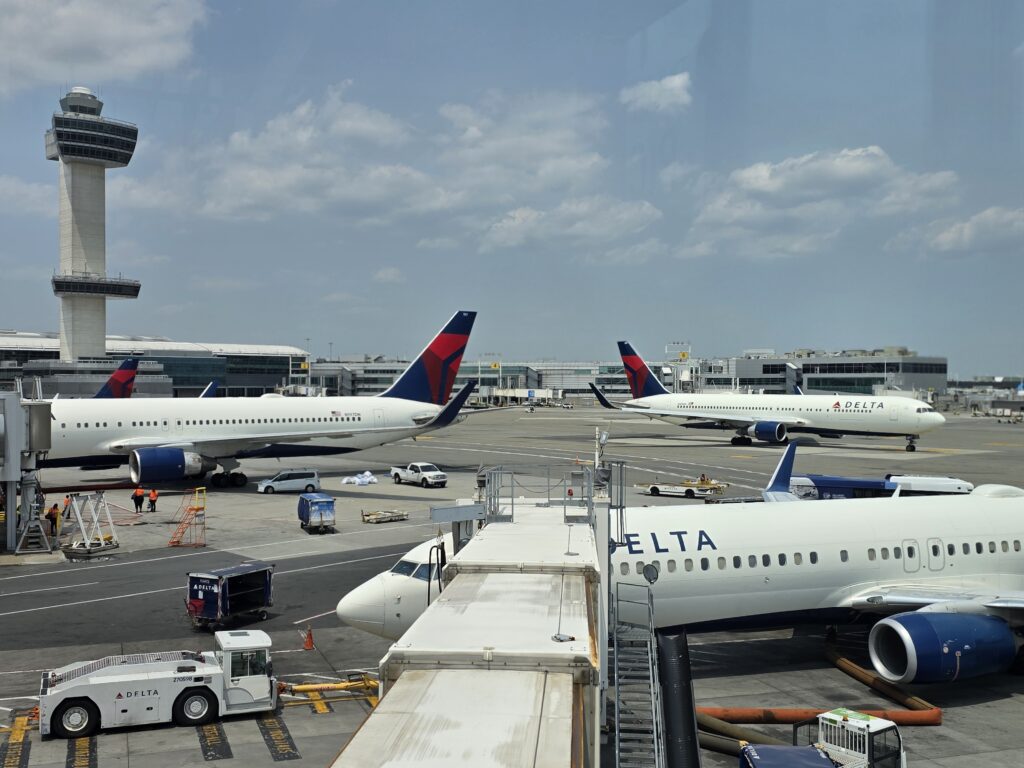A Delta Airlines Boeing 737-800 flew from Orlando to Austin on Tuesday with a partially broken, dislodged piece of the wing. Despite the dislodged outboard left flap, flight 1893 landed safely. Here’s video of the broken piece, inflight and as the aircraft landed:
Passenger video shows a detached wing flap on an Austin-bound Delta flight on Tuesday. ♂️ pic.twitter.com/oE8Mvd0wSj
— Trumpusa1 (@Trumpusa1A1) August 21, 2025
WATCH: Delta Boeing 737-800 flight DL1893 from Orlando landed in Austin yesterday with the left wing aft flap detached.
: Shanila Arif pic.twitter.com/C7eI5AdG6Y— Turbine Traveller (@Turbinetraveler) August 21, 2025
Something similar happened last month – a trailing‑edge wing flap from Delta Flight 3247, a Boeing 737‑900 that flew from Atlanta to Raleigh‑Durham, was discovered in the driveway of a Raleigh home. Crew remained unaware anything was amiss until the inspection upon landing.
Delta Boeing 737-900ER wing flap was also found on a driveway in a Raleigh neighborhood back in July. pic.twitter.com/WV2i9xz9BD
— Turbine Traveller (@Turbinetraveler) August 21, 2025
Usually pilots wouldn’t have warning for something like this. The 737’s flap logic looks for left‑right mismatches while the flaps move. If both main flaps travel together and their sensors agree, the system is happy. There’s no sensor that says “hey, your small aft panel fell off.” So unless the movement becomes uneven or skewed, there’s no caution message.
- At cruise with flaps up, the missing piece slightly changes the wing’s shape on the left side, but it’s minor. Autopilot and trim erase it.
- On approach with flaps down it becomes noticeable. The right wing (with all its flap area intact) creates a bit more lift and drag, so the jet wants to bank left. The fix is simple: a touch of right aileron and right rudder. This would be steady and not dramatic. The pilot might notice a little vibration.
- There is some handling hazard on landing, but it’s manageable (not zero). There’s some asymmetric lift and drag at low speed. There may be slightly less stall margin on the damaged side. The left wing no longer has as much “effective flap” as the right. The ideal target landing speed would be a hair higher than the computer assumed. You land normally with a bit of wheel into the “light” wing.
- The real issues are more pilot workload at slow speed because the plane isn’t perfectly symmetrical (add a touch of speed/authority) and falling debris if the piece detaches inflight as we saw that in the Raleigh incident last month).
- If a piece half‑detached and jammed another surface (flap, aileron, fairing), you could have a control‑jamming problem during extension. That wasn’t in place here.

Carriers keep an eye on 737 trailing‑edge hardware in general because wear or cracking at tracks and attachments can lead to losing a flap segment and reduced controllability. That’s a different mechanism than a single aft panel separating, but it’s why this area gets scrutiny.
Here, the small aft section of the left flap is missing. That won’t trigger a cockpit alert by itself, and in cruise the crew might not notice much. On approach, they’ll feel a gentle left‑roll tendency and it was easily manageable. The landing is straightforward, though workload is higher and the ideal speed margin is a little more than planned. The larger risk is the part falling somewhere it shouldn’t, not the airplane being uncontrollable.

I’d love for the commercial pilots, especially 737 pilots, among my readers to share their perspective if I’m missing something (I have a decent amount of sim time only – am definitely not a pilot).


Premium wing flaps clearly!
Hey Boeing. Why not take a permanent marker and write the aircraft tail number on the wing flaps? This way, when they fall off, first responders can quickly identify which aircraft is missing an aft panel that may have crashed through the roof of a home or a vehicle sunroof.
I’ve often wondered if Delta waves more maintenance issues vs United and AA.
Their mechanics have no protection from at-will firing and are thus clearly more impacted by the importance of an operation than their union-represented friends at AA and UA. By that alone, they’d clearly have more incentive to keep the plane flying.
My own personal experience recently is on a 30-year old Airbus in First on Delta. The “remodeled” plane literally had lights and entire overhead panels falling out of the entire first class area yet Delta kept the plane flying. I’ve seen AA fly with a gross first class seat out of commission (but it’s blocked and not used, just an eyesore) but this Delta plane I was on had pretty clear electrical cords just hanging from the ceiling. Coupled with how the plane felt like a toy aircraft with no wind (looking at the flaps, they seemed to just be wobbling on the wing — something I haven’t experienced on any AA Airbus aircraft).
Delta, against all odds, maintains a higher operational performance with fewer spare aircraft and an older fleet vs AA. It does make you wonder if their mechanics just let a lot more slide since they have little recourse to keep a plane flying, if pressured.
@Ken A
I know it’s easy to dump on Boeing these days but this is a 25 year old plane…
*waives
Waives with the letter i in the middle of the word, not waves. As in,
I don’t ask for any waivers for proper spelling of homophones in my online comments; my commitment to spelling words correctly is unwavering.
@Julie — I agree that Delta’s flight attendants, mechanics, and ground workers should join their dispatchers and pilots (since 1934!) in organizing.
That said, issues with aircraft can and do happen, regardless; glad everyone was alright here!
It’s early, Sorry JimC2. You are correct.
1990, these issues do happen, absolutely. I’m sure there are examples of AA and UA with similar issues but I can’t actually recall the last time we heard about part of a wing falling off an AA or UA aircraft. United had the infamous engine issue on a 77A over the Pacific years ago now but I haven’t heard anything similar to a flap just falling off for any major airline aside from Delta in recent memory. Perhaps it’s just recency bias. My own personal experience recently just was rather shocking to see electrical cords dangling in front of me in first class. I mentioned it to the Flight Attendants and they just laughed and said “yeah, that’s not uncommon. just don’t touch it”
picking anecdotes out of thin air for a fleet of almost 1000 aircraft means precisely… nothing.
Gary posts pictures repeatedly of AA aircraft with broken pieces. UA aircraft have had multiple major incidents that are related to maintenance.
The FAA and NTSB will investigate as they should. It is entirely possible that there is a systemic issue w/ the flap attachments on the 737. It is also possible that DL maintenance or their contractor may have misinstalled something; it’s not like AA hasn’t had multiple issues with misinstalled parts on the 737.
someone needs to figure it out. Pointing fingers early in an investigation rarely ends up highlighting anywhere close to the truth.
and it is a tribute to the 737 that the plane landed as smoothly as it did w/ one flap hanging off the back of the wing.
@Julie — This incident is likely one of those ‘it looks worse than it is’ situations. And, if we really need to start comparing, this is far better than losing a ‘door plug’ like on AS 1282.
I tend to agree with @Tim Dunn, kudos to the crew, and wouldn’t hold this one-off against Delta or any airline when it inevitably happens to them, too.
It’d be more of an issue if a pattern emerged, like, if repeatedly the same airline starts having the same issue (then I might think ‘sabotage’.)
It’s anecdotal, but I’ve been on ample recent domestic and international flights with DL, B6, AA, and UA, on a variety of aircraft, all of which seemed well-maintained.
Unless circumstances change, I still trust US carriers to prioritize our safety (if they could then focus on ‘punctuality,’ that’d be swell, but I appreciate that there is often a ‘hierarchy of needs’).
That said, nothing is without risk. Jet aircraft are still metal tubes with wings and mini-rockets going +500 mph at over 30,000 feet. So, if our time comes, it has been nice…
Seriously, though, I am yet to feel unsafe on-board any of these airlines. Even when incidents occur, the crews will do their best to remedy as here.
*re-reads post*
“Second Delta 737 In Six Weeks…”
Eh, probably just a coincidence…
Next month, Gary posts: “Third De…”
*gulp*
Is it me, or did that flip split in half? Looks to me like it’s only half the flap and the other one is sitting on the ground somewhere. I have no idea what would have been the root cause for that, which makes it interesting.
@Julie, I was just trying to have a bit of fun with wordplay. I feel kinda bad that you apologized!
That’s a smart question about differences in how each airline manages their maintenance (within the legal boundaries set by the FAA, of course).
“On approach with flaps down it becomes noticeable. The right wing (with all its flap area intact) creates a bit more lift and drag, so the jet wants to bank left”. I’m no pilot, but I am an engineer. My guess would have been that it would tend to bank right, perhaps some pilots that follow this blog could comment.
@JimC2
Not at all. I dislike spelling mistakes, as well. I missed that one!
Tim,
“picking anecdotes out of thin air for a fleet of almost 1000 aircraft means precisely… nothing.”
Did you have an example of electrical wiring falling out of AA and UA ceilings recently like my example? Much less Flight Attendants laughing about it to their first class passengers? How about wing flaps falling off?
Or to my point about how Mechanics at Delta have no “cover” from their union if they make a difficult choice to ground a plane when their operational leaders disagree. I’m noting the incentive alignments with Delta mechanics. It just isn’t that way when your mechanics are unionized. They can make difficult decisions where management disagrees with you without repercussions. A Delta mechanic can file a whistle blower complaint or tell the press after they’ve been fired but they simply do not have similar work rule or union protection to make difficult decisions that the operational leadership may disagree with.
Is this happening? I don’t know. But neither do you and the incentives are rather obvious and I just haven’t seen flaps falling off planes or things like electrical cords waived as they fall out of the ceiling.
“That said, nothing is without risk. Jet aircraft are still metal tubes with wings and mini-rockets going +500 mph at over 30,000 feet. So, if our time comes, it has been nice…”
Your commitment to safety is appreciated. I think my safety expectations are higher than this.
@Julie — I, not Tim, said that last part, and a lot more that you cut out… but, whatever. If you’re genuinely concerned about flying, I wouldn’t worry too much; if you’re just trying to attack Delta, we can find fault with each company; if you’re promoting unions, generally, then I happen to agree, but I don’t think it would have made much difference in this particular context.
“Did a piece of my gorram plane fall off for no apparent reason?”
Julie,
if you truly were objective, you would have data. UA had a number of issues last year of things falling off planes. The FAA investigated and found no trends.
They will do the same w/ these DL 737 issues.
It is precisely because you want to throw shade rather than deal w/ facts and data that you post what you do, which is precisely why 1990 accurately noted reality.
Come I never find 737 parts on my driveway?
Careful what you ask for: I know people in the north Denver suburbs that had United Airlines 777 engine parts rain down in their neighborhood a few years back…
@Denver Refugee — Better than ‘raining men,’ I guess…
Stuff like this isn’t supposed to happen on PERFECT airlines. Lol
@DesertGhost — The only ‘perfect’ airline is Qantas… ‘never crashed.’
… but had some wild mechanical failures that nearly took down airplanes.
Well Timmy, bless your statistic-lovin’ little heart. You come in here spoutin’ about ‘anecdotes’ like we’re talkin’ frequent flyer points instead of flaps fallin’ clean off airplanes. Baby, this ain’t somebody forgettin’ their carry-on — this is hardware leavin’ the chat at 35,000 feet.
And you wanna hide behind that ‘fleet of 1000 aircraft’ line like it’s your emotional support blanket. Sugar, when two wing parts decide to take solo vacations — one droppin’ into a driveway like a door prize and another hangin’ over Austin like leftover confetti — that’s not a statistic, that’s a pattern.
So while you’re sittin’ there polishin’ Delta’s halo like it’s the crown jewels, the rest of us are just sayin’, maybe… just maybe… somebody oughta grab a wrench before the next flap files for early retirement. Now hush, darlin’, before you try to tell us a missing wing is just ‘routine operations.’
Timmy, I swear, if Delta sneezed, you’d write three paragraphs defendin’ their tissues.
@Dean: I have a great appreciation for Boeing aircraft. As you noted, it took 25 years for some components of this aircraft to detach from the fuselage. Whenever aircraft parts fall to the ground, the public often finds itself bewildered about what the piece is and which aircraft has lost it. With the tail number marked on these critical components, the airline dispatcher may be able to notify the pilot in command of the affected aircraft, informing them that parts of their plane landed before they did and that their flight may encounter problems related to a safe landing.
well, Anita, you sure have suddenly stormed the internet aviation world. Which one of the last 27 personalities that you have used didn’t work out?
No, sweetheart. I’m not defending DL any more than I was willing to wait for investigators to figure out what happened with any other aviation incident.
Perhaps in your limited free time you can find my comments about who was at fault for any of AA, UA or WN’s operational issues over the past year.
@Tim Dunn — You may appreciate that I’m on a Delta 739 right now, domestic First, enjoying that Free WiFi for SkyMiles members; clean, safe aircraft, relatively on-schedule, and a pretty tasty short-rib, lemon cake dessert. You know what else is nice? Those mini-water bottles waiting for us at our seats (United and American don’t do that), and also, Grown Alchemist soap AND hand moisturizer in the forward lavatory (again, way better than American’s Radio Bombay or United’s passion fruit scented stuff). It’s the little things.
Oh Timmy, bless your little fanboy heart. I know it must sting that not everyone swoons when you rattle off your Delta bedtime stories, but accusing me of having “27 personalities” is rich coming from the man who’s been caught sock-puppeting his own arguments. Projection much?
And let’s be clear — pointing out Delta’s shortcomings doesn’t mean I’m suddenly an apologist for AA, UA, or WN. Unlike you, I don’t treat airlines like they’re a football team I’ve pledged lifelong loyalty to. I’m interested in policy, passengers, and performance — not who gets the most shiny corporate PR spin.
So maybe instead of clutching your pearls about me, you could spend that “limited free time” of yours rereading your own archives. You know, the ones where you excuse Delta’s every stumble but magically find a villain in every other carrier.
Some of us call that bias. You call it “analysis”
Projection is cute on a movie screen, Timmy. Less so in your comments.
@Tim Dunn — I’m not sure why @Anita Grits is so worked-up, but you’re always welcome to share these so-called ‘Delta bedtime stories’ with the rest of us on here. I’ll enjoy them at least! (Keep climbing! 100 more years!)
[“On approach with flaps down it becomes noticeable. The right wing (with all its flap area intact) creates a bit more lift and drag, so the jet wants to bank left”. I’m no pilot, but I am an engineer. My guess would have been that it would tend to bank right, perhaps some pilots that follow this blog could comment.]
I am not a pilot but it seems simple and correctly explained to me. The wing with more lift will go up and in response the the other wing will go down. With no adjustments to the controls, the plane will bank in the direction of it’s lowest wing. Every flight I have been on has done banked turns and they are always in the direction of the lowest wing. The amount of drag caused by a damaged flap versus a good flap may not be easy to quantify. But for argument, if the good right flap has more drag, the airplane should slowly pull to that direction. If everything else was equal, including the lift, the turn would be flat. My guess is the banked turn is more responsible for the outcome than the drag is. With enough control surfaces still working, the asymmetric forces can be counteracted. Military airplanes have made it back to base with half a wing and more missing and landed without killing the pilot.